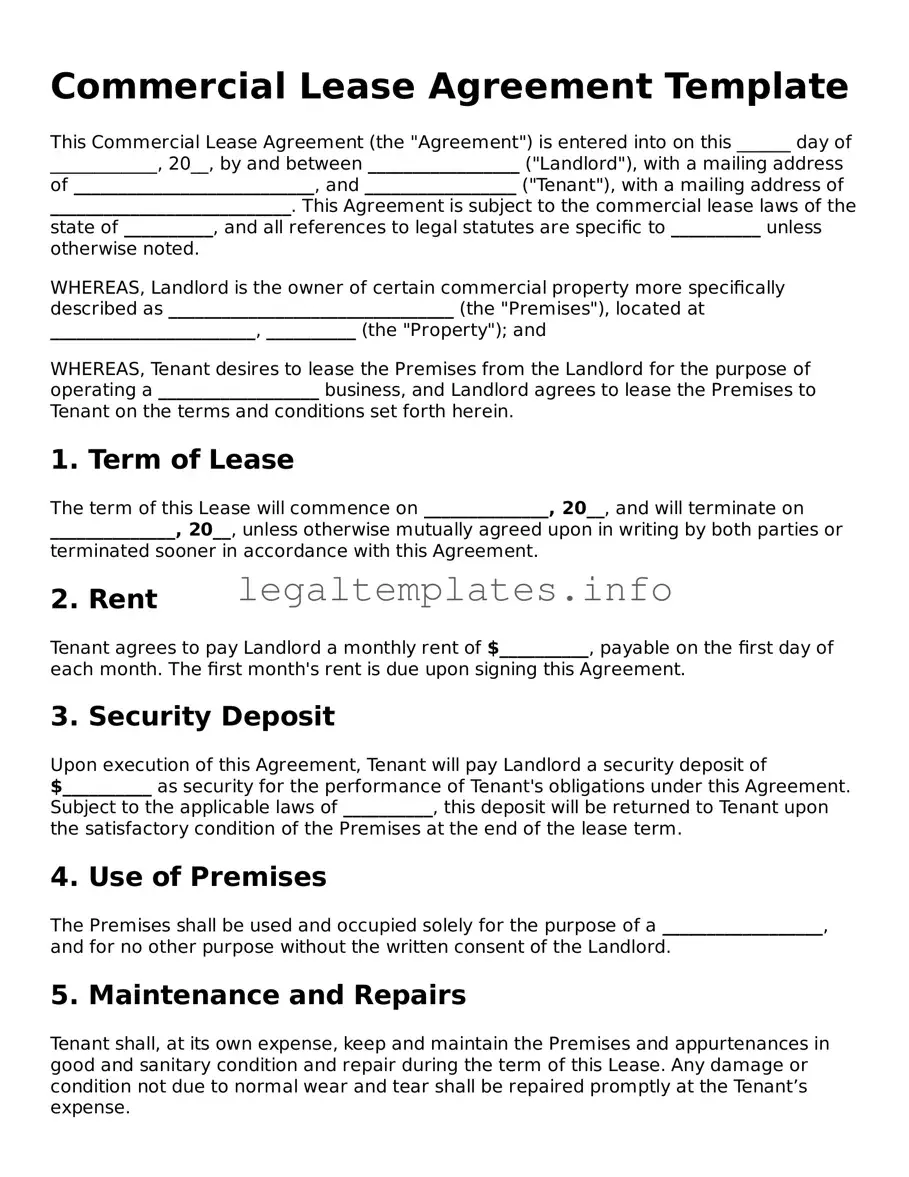Commercial Lease Agreement Template
This Commercial Lease Agreement (the "Agreement") is entered into on this ______ day of ____________, 20__, by and between _________________ ("Landlord"), with a mailing address of ___________________________, and _________________ ("Tenant"), with a mailing address of ___________________________. This Agreement is subject to the commercial lease laws of the state of __________, and all references to legal statutes are specific to __________ unless otherwise noted.
WHEREAS, Landlord is the owner of certain commercial property more specifically described as ________________________________ (the "Premises"), located at _______________________, __________ (the "Property"); and
WHEREAS, Tenant desires to lease the Premises from the Landlord for the purpose of operating a __________________ business, and Landlord agrees to lease the Premises to Tenant on the terms and conditions set forth herein.
1. Term of Lease
The term of this Lease will commence on ______________, 20__, and will terminate on ______________, 20__, unless otherwise mutually agreed upon in writing by both parties or terminated sooner in accordance with this Agreement.
2. Rent
Tenant agrees to pay Landlord a monthly rent of $__________, payable on the first day of each month. The first month's rent is due upon signing this Agreement.
3. Security Deposit
Upon execution of this Agreement, Tenant will pay Landlord a security deposit of $__________ as security for the performance of Tenant's obligations under this Agreement. Subject to the applicable laws of __________, this deposit will be returned to Tenant upon the satisfactory condition of the Premises at the end of the lease term.
4. Use of Premises
The Premises shall be used and occupied solely for the purpose of a __________________, and for no other purpose without the written consent of the Landlord.
5. Maintenance and Repairs
Tenant shall, at its own expense, keep and maintain the Premises and appurtenances in good and sanitary condition and repair during the term of this Lease. Any damage or condition not due to normal wear and tear shall be repaired promptly at the Tenant’s expense.
6. Alterations
No alterations, additions, or improvements shall be made by Tenant without the prior written consent of the Landlord. All alterations become the property of the Landlord upon termination of this Agreement.
7. Insurance
The Tenant shall maintain, at its own expense, a comprehensive general liability insurance policy covering the Premises and its operations therein. Proof of insurance must be provided to the Landlord upon request.
8. Compliance with Laws
Tenant agrees to conduct its business in compliance with all applicable federal, state, and local laws, ordinances, and regulations.
9. Termination
This Agreement may be terminated by either party upon written notice if the other party breaches any terms or conditions of this Agreement and fails to correct such breach within ______ days of written notification.
10. Governing Law
This Agreement shall be governed by, and construed in accordance with, the laws of the state of __________.
Signatures
IN WITNESS WHEREOF, the Parties hereto have executed this Commercial Lease Agreement as of the day and year first above written.
Landlord Signature: __________________________________ Date: ___________
Tenant Signature: ___________________________________ Date: ____________
Witness Signature: __________________________________ Date: ____________
This document is intended to be a general template. Specifics should be tailored to the parties' individual needs and in compliance with applicable law in the respective state. It is recommended to seek legal review and advice to ensure the completeness and compliance of this Agreement.
